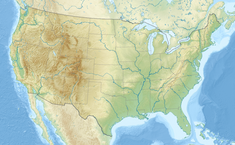
Summary
Cliffside Gas Field is located in the Texas Panhandle bearing 9 miles (14 km) west of Texas Highway 87 and 15 miles (24 km) northwest of Amarillo, Texas. The Great Plains Panhandle area is located in Potter County, Texas within the vicinity of the unincorporated community Cliffside, Texas.[2]
| Cliffside Gas Field | |
|---|---|
 Helium Enrichment Unit in the Cliffside Gas Field outside Amarillo, Texas | |
  | |
| Location | Potter County, Texas |
| Offshore/onshore | Onshore |
| Coordinates | 35°21′09″N 101°59′31″W / 35.35250°N 101.99194°W |
| Field history | |
| Discovery | 1910 |
| Start of development | May 1925 |
| Start of production | April 1929 |
| Production | |
| Producing formations | [1] |
The Potter County oil and gas reservoir was permitted for fossil fuel exploration in May 1925. The Panhandle basin was nationally recognized as a helium reserve with an estimated 100 billion cubic feet (2.8 billion cubic metres) of discovered natural gas at the Cliffside field.[3]
Amarillo Helium Plant edit
In April 1929, the United States government purchased 50,000 acres (20,000 ha) for a helium extraction plant located in west Amarillo within the unincorporated community of Soncy, Texas.[3][4][5]
By August 1929, the Texas Panhandle helium plant received notable commendations from national news sources regarding the plants estimated helium gas production yields.[6]
The Amarillo plant operated from 1929 to 1943 producing helium meeting the global demand for the monatomic gas. In 1968, the helium industry celebrated a centennial claiming Potter County, Texas as the "Helium Capital of the World."[7][8]
First Helium Reservoir in North Texas edit
The Petrolia Oil Field was located 18 miles (29 km) northeast of Wichita Falls, Texas. The oil and gas reservoir was the primary helium source for the United States during the 1910s and at the commencement of World War I. By 1921, the North Texas natural gas field was estimated as near gas depletion exceeding the Petrolia helium reserves-to-production ratio yields.[3]
See also edit
| Air separation | National Helium Reserve |
| Hampson–Linde cycle | Natural-gas processing |
| Helium Act of 1925 | Non-rigid airship |
| Hugoton Gas Field | Rigid airship |
| List of airship accidents | Semi-rigid airship |
References edit
- ^ "Explore Texas Geology". United States Geological Survey. U.S. Department of the Interior.
- ^ U.S. Geological Survey Geographic Names Information System: Cliffside Gas Field Camp
- ^ a b c Smith, Julia Cauble. "Panhandle Field". Handbook of Texas Online. Texas State Historical Association.
- ^ Olien, Diana; Olien, Roger (2002). Oil in Texas, The Gusher Age, 1895-1945. Austin, Texas: University of Texas Press. p. 145. ISBN 978-0292778863. OCLC 46969843.
- ^ Smith, Richard (1965). The Airships Akron & Macon, The Flying Aircraft Carriers of the United States Navy. Annapolis: Naval Institute Press. p. 15. ISBN 0870210653.
- ^ Anonymous (August 14, 1929). "HELIUM OUTPUT RISES IN ARMY'S TEXAS PLANT; 648,850 Cubic Feet Produced in July--Steady Manufacture at Lowered Cost Under Way". The New York Times. p. R24.
- ^ "Amarillo Helium Plant - Potter County ~ Marker Number: 144". Texas Historic Sites Atlas. Texas Historical Commission. 1965.
- ^ Kleiner, Diana J. "Helium Production". Handbook of Texas Online. Texas State Historical Association.
Historical Video Archive edit
- Rudnick, Isidore (1977). "The Unusual Properties of Liquid Helium". Internet Archive. San Francisco Film Services.
- Exploring Abandoned Amarillo Helium Plant on YouTube
External links edit
- "Energy and Minerals - Helium". Bureau of Land Management (BLM). U.S. Department of the Interior.
- Alsobrook, Adam. "Taking Preservation Lightly: Historic Helium Plants in Texas". Texas Historical Commission.
- Anderson, H. Allen. "Exell Helium Plant". Handbook of Texas Online. Texas State Historical Association.
- "Helium Time Columns Monument and Museum - Amarillo ~ Marker Number: 2430". Texas Historic Sites Atlas. Texas Historical Commission. 1968.
- University of Kansas (April 15, 2000). "Discovery of Helium in Natural Gas at the University of Kansas". National Historic Chemical Landmarks. American Chemical Society.
- Boissoneault, Lorraine (August 17, 2018). "How Scientists Discovered Helium, the First Alien Element, 150 Years Ago". Smithsonian Magazine. Smithsonian.com.


